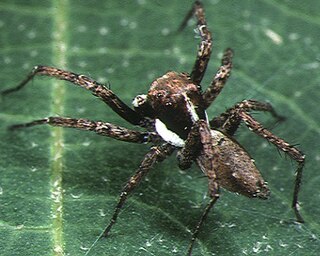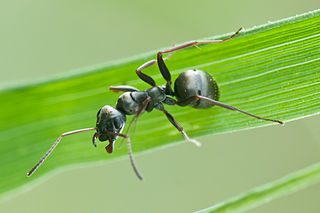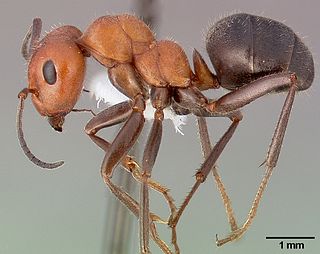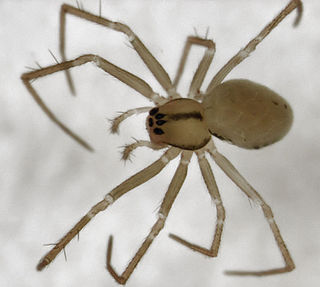
Arachnida is a class of joint-legged invertebrate animals (arthropods), in the subphylum Chelicerata. Arachnida includes orders containing spiders, scorpions, ticks, mites, harvestmen, and solifuges. In 2019, a molecular phylogenetic study also placed horseshoe crabs in Arachnida.

The Opiliones are an order of arachnids colloquially known as harvestmen, harvesters, or daddy longlegs. As of April 2017, over 6,650 species of harvestmen have been discovered worldwide, although the total number of extant species may exceed 10,000. The order Opiliones includes five suborders: Cyphophthalmi, Eupnoi, Dyspnoi, Laniatores, and Tetrophthalmi, which were named in 2014.

Ultimate tensile strength (UTS), often shortened to tensile strength (TS), ultimate strength, or within equations, is the maximum stress that a material can withstand while being stretched or pulled before breaking. In brittle materials the ultimate tensile strength is close to the yield point, whereas in ductile materials the ultimate tensile strength can be higher.

Jumping spiders or the Salticidae are a family of spiders. As of 2019, it contained over 600 described genera and over 6000 described species, making it the largest family of spiders at 13% of all species. Jumping spiders have some of the best vision among arthropods and use it in courtship, hunting, and navigation. Although they normally move unobtrusively and fairly slowly, most species are capable of very agile jumps, notably when hunting, but sometimes in response to sudden threats or crossing long gaps. Both their book lungs and tracheal system are well-developed, and they use both systems. Jumping spiders are generally recognized by their eye pattern. All jumping spiders have four pairs of eyes, with the anterior median pair being particularly large.

Formica is a genus of ants of the family Formicidae, commonly known as wood ants, mound ants, thatching ants, and field ants. Formica is the type genus of the Formicidae, and of the subfamily Formicinae. The type species of genus Formica is the European red wood ant Formica rufa. Ants of this genus tend to be between 4 and 8 mm long.

An ant colony is the basic unit around which ants organize their lifecycle. Ant colonies are eusocial, communal, and efficiently organized and are very much like those found in other social Hymenoptera, though the various groups of these developed sociality independently through convergent evolution. The typical colony consists of one or more egg-laying queens, numerous sterile females and, seasonally, many winged sexual males and females. In order to establish new colonies, ants undertake flights that occur at species-characteristic times of the day. Swarms of the winged sexuals depart the nest in search of other nests. The males die shortly thereafter, along with most of the females. A small percentage of the females survive to initiate new nests.

Portia is a genus of jumping spider that feeds on other spiders. They are remarkable for their intelligent hunting behaviour, which suggests that they are capable of learning and problem solving, traits normally attributed to much larger animals.

Formica fusca is a black-colored ant commonly found throughout Europe as well as parts of Southern Asia and Africa. The range within the palaearctic region extends from Portugal in the west to Japan in the east and from Italy in the south to Fennoscandia in the north. Populations from North America have been split off as a separate species, Formica subaenescens. F. fusca nests are usually found in rotten tree stumps or under stones in clearcut areas and along woodland borders and hedgerows.

Formica sanguinea, or blood-red ant, is a species of facultative slave-maker ant in the genus Formica characterized by the ability to secrete formic acid. It ranges from Central and Northern Europe through Russia to Japan, China, the Korean Peninsula, Africa and also the United States. This species is coloured red and black with workers up to 7 mm long.

Mauro Abel Formica is an Argentine footballer who plays as an attacking midfielder for Newell's Old Boys in the Argentine Primera División. He is nicknamed El Gato.

Formica obscuripes is a species of ant in the family Formicidae. It is native to North America. It produces large mounds covered by small pieces of plant material. The number of adult workers per colony may be as high as 40,000. F. obscuripes feeds upon a number of insect species, consumes nectar from homopterous insects they tend, and occasionally eats plant tissue. In the Blue Mountains of Oregon, F. obscuripes has demonstrated the capacity for polydomy. A supercolony in a four-hectare study area near Lehman Hot Springs consisted of 210 active nests with an estimated population in excess of 56 million ants.
Alfred Frank Millidge was a British arachnologist who wrote several works on spiders. One of his best-known might be British Spiders, volumes I and II, which he co-wrote with G. H. Locket. In 1983, he became the first person to describe the spider species Walckenaeria crocea.
The World Spider Catalog (WSC) is an online searchable database concerned with spider taxonomy. It aims to list all accepted families, genera and species, as well as provide access to the related taxonomic literature. The WSC began as a series of individual web pages in 2000, created by Norman I. Platnick of the American Museum of Natural History. After Platnick's retirement in 2014, the Natural History Museum of Bern (Switzerland) took over the catalog, converting it to a relational database.

Drapetisca alteranda is a spider in the family Linyphiidae. It is found in the United States.

Drapetisca australis is a spider in the family Linyphiidae. It is found in the Antipodes Islands.
Ceraticelus innominabilis is a spider in the family Linyphiidae. It is found in Alaska.
Tennesseellum gollum is a species of spider in the family Linyphiidae. The species is named after the fictional character Gollum from the works of J. R. R. Tolkien, in reference to "the 'evil look' of the male of this species due to the large cheliceral tubercles." Native to the Southwestern United States, it was described based on an individual collected in Anza-Borrego Desert State Park, Southern California.
Phruronellus formica is a species of true spider in the family Phrurolithidae. It is found in the United States.

Synemosyna formica, is an ant-mimicking jumping spider in the family Salticidae. It is found in the eastern United States and parts of Canada.













